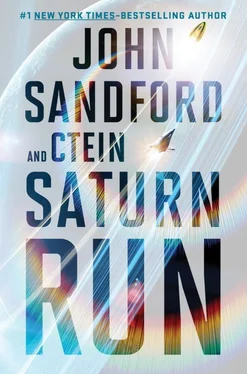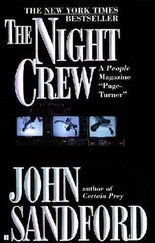Captain Fang-Castro looked from the visitor sitting across the desk, to the screen on the wall opposite. The screen was divided into chunks, the chunks growing or shrinking depending on who was speaking. The occupants of the screen’s real estate were scattered across the U.S., the best and brightest geeks that DARPA money could buy. Which was pretty damn good, she’d found out back when she was a DARPA liaison.
They were the reigning heavyweight champions of design, putting together a system that would kick her station across 1.5 billion kilometers of empty space, to a rendezvous with who-knows-what.
The geeks were not happy.
Their unhappiness was focused on the challenger, a short, round blonde who was part of a team ferried up by Crow, who’d told Fang-Castro that the blonde, Rebecca Johansson, was probably the best in the world at what she did, which was designing power and heat flow management systems.
Fang-Castro was still getting a read on the engineer; she mixed the soft-spoken style of a well-raised Midwestern woman with the social graces of an engineer, which was to say, not all that many.
She was quiet, pleasant, and blunt.
Johansson was wrapping up her spiel. “That’s about the size of it. Literally. If we try to run ordinary low-temperature heat radiators, they will be so many kilometers in size that the mass will kill us—they’ll be larger than the mass budget for the entire ship. We need to go to high-temperature radiators, I’m thinking around six hundred Celsius, with molten metal heat exchangers. Then I can pump the heat from the reactors fast enough, and get the waste heat into the radiators fast enough, to dump all of that waste heat into space with a radiator that’s a few percent of the size we’d need otherwise.”
One of the earth engineers started to jump in, but Johansson cut him off. “I know the reactors are up to it, don’t tell me they’re not. You can get a lot better than a gigawatt out of a ton of core, and I can siphon it off with pressurized liquid sodium at around two thousand Celsius. You can either boil that directly or run a secondary boiling sodium cycle to run the primary turbines at nineteen hundred Celsius and a downstream supercritical water vapor turbine to get the exhaust down to six hundred and fifty Celsius, and I can take it from there.”
The face of one of the earthbound engineers, Harry Lomax, ballooned in size on the view screen, as he waved his hands in frustration. “Are we really supposed to consider this? It’s nuts. There’s no possible way.”
From the corner of her eye, Fang-Castro saw Johansson about to jab back. Without taking her eyes from the monitor and the engineer, she waved one hand at the blonde in a way that said, Wait. I’m the referee. Let me ref.
“Harry,” Fang-Castro said, “you’re saying it’s literally impossible? Because if it is, if this is simply a dreadful mistake on Ms. Johansson’s part, I’ll be happy to dismiss our new engineer and request someone better suited to the task.”
The blonde opened her mouth, Fang-Castro waved again, and the blonde closed her mouth.
Lomax paused a moment, disconcerted by the opening he’d been handed. Fang-Castro waited patiently.
“Okay, maybe the wrong choice of words,” Lomax said. “It’s not physically impossible: it doesn’t violate any known physical laws and it doesn’t require materials we haven’t invented yet. But it’s completely and utterly unrealistic.”
“So what you’re saying is, it’s a possible solution in a terribly difficult situation, you just don’t have the wherewithal to do your part of the required design.”
“That’s not exactly what I was saying…”
Fang-Castro pointed to Becca, who said, “I agree with Dr. Lomax that the whole mission timetable is ridiculous and unrealistic, but it is what it is. Dr. Lomax, you can design all the reactors you want, but if they melt, they ain’t going to Saturn. We gotta get rid of the heat. That’s not optional. Run the numbers yourself. If you’ve got a better suggestion than mine, I’d be delighted to hear it.”
Fang-Castro jumped in: “Harry, I agree with Dr. Johansson here. We’ve got to get rid of the heat. I also agree with you: this solution does strike me as unrealistic. Come back to me with a better idea. Quickly, if you please. Orders need to be cut.”
Lomax wasn’t ready to let it go. “Dr. Johansson’s scheme wastes huge amounts of energy. We’ll need to scale up the entire power plant by fifty percent to compensate, and we still have to stay within our weight budget. I don’t see how.”
“That’s why I’m giving you options,” Fang-Castro said. “You can come up with a different way to handle the heat management, or figure out how to upscale the power plant. Give me a call when you get that figured out. Tomorrow would be good.”
Fang-Castro shut down the conference window and turned back to her guest.
“So, Becca: Will they come up with a better idea? And if not, can they build the power train you need?”
Becca chewed the end of a stylus for a few seconds, then her eyes flicked up to Fang-Castro’s. “I don’t believe there is a better idea. The DARPA guys are really smart, and maybe I’ve overlooked something, but I don’t think so. I want to be clear: I’m not saying my solution is optimal, but there is some basic thermodynamics at work here, and my solution is as good as it gets, with the timetable that’s been imposed on us. I’m pretty sure I can handle my side of the engineering. As for them handling theirs, I don’t know. I’ve seen refractory ceramic composite turbines demonstrated that ought to do the job, but that’s not really my expertise. Maybe they’ll find they can’t do it. I’m not sure there’s anything else. So, no: they won’t find a better idea.”
“Good enough, Becca.” Fang-Castro sighed. The whole mission was right on the bleeding edge of insanity. “I’ll get someone to take you down to Engineering so you can get a feel for our current environment.”
____
John Clover didn’t have to take pictures of the station, or set up news reports about it; he didn’t have to worry about anything but his brain. And the cat.
Chapman, the tall, thin woman, led him to the elevator-equivalent that took them to Habitat 1. “We’re having a get-together in the Commons in fifteen minutes,” she told him “An informal affair, open to anyone who wants to come, but there were already quite a few there before you arrived.”
“The Commons. That sounds a trifle ominous,” Clover said. “Like the place where the aliens touch their heads together while they’re getting Roto-Rootered by the Leader.”
“Okay. Call it the cafeteria,” Chapman said. “It’s that, too, at mealtimes. Anyway, we can drop your stuff and the cat at your cabin—the cat should sleep for a while yet, and we’ve already set up a cat pan and so on—and let you wash your face or whatever.”
“I do have to whatever,” Clover said. “But I don’t want to hold people up. I hope Mr. Snuffles is okay.”
“I’m sure he is. We’ve had a couple of cats up here before, you know. They were subjects of various experiments. They adapt quite well.”
“Good. I’m a little worried.”
Clover took a leak and washed his face, and Chapman escorted him to the Commons, where twenty-five or thirty people were waiting. They stood and applauded, which made Clover smile, and Chapman led him to a lectern, gave a brief introduction, and Clover said, “I have no prepared comments. I didn’t know they might be needed. The main reason I’m up here is to see if I can stand it… being up here. So far, so good. I just keep saying to myself, ‘Put your foot down, John.’ Anyway, maybe I’ll give a talk some other time, but right now, I’ll put it on you-all. Ask me questions: ask me anything.”
Читать дальше








